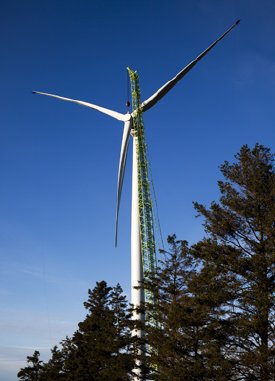Dec 7 2009
Siemens Energy has installed the first prototype of a newly designed direct-drive wind turbine. The new SWT-3.0-101 DD is a gearless machine with a power rating of three megawatts (MW). It has a rotor diameter of 101 meters. The prototype was installed close to the Danish town of Brande, where Siemens Wind Power headquarters is located. Direct drive wind turbines offer a smart, straightforward design that makes the use of gearboxes dispensable. Siemens will thoroughly test and validate the performance of the SWT-3.0-101 before the new product will be officially launched for sale in 2010.
 The picture shows the new SWT-3.0-101 DD wind turbine, which was installed close to the Danish town of Brande. The new prototype is a gearless machine with a power rating of three megawatts (MW) and has s rotor diameter of 101 meters.
The picture shows the new SWT-3.0-101 DD wind turbine, which was installed close to the Danish town of Brande. The new prototype is a gearless machine with a power rating of three megawatts (MW) and has s rotor diameter of 101 meters.
"Compared to a standard wind turbine with gearboxes we managed to reduce the number of parts in the new SWT -3.0-101 DD by half”, said Henrik Stiesdal, CTO of the Siemens Wind Power Business Unit. “With fewer moving parts, the direct drive technology has the potential to significantly reduce maintenance time, which could result in even higher turbine availability.” The new machine will primarily be targeted for high-end onshore markets.
The new SWT-3.0-101 DD features a new, compact synchronous generator excited by permanent magnets. The generator was produced by the Large Drives Business Unit within the Siemens Industry Sector. The main advantage of permanent magnet generators is their simple and robust design that requires no excitation power, slip rings or excitation control systems. This leads to high efficiency even at low loads.
“One and a half years after starting the testing of two direct-drive concept wind turbines we are now confident that this technology is a sound base for future Siemens wind turbines”, said Stiesdal. In July 2008, Siemens installed the first of two 3.6-megawatt direct drive concept turbines. The purpose was to assess whether direct drive technology is competitive with geared machines. Stiesdal: “We can now conclude that the concept machines are operating with an excellent performance and that we are ready to move ahead with developing the concept into a commercially competitive product.”
“We will continue to develop new wind turbines based on the standard gearbox design as these machines have proven to be exceptionally robust and reliable”, said Henrik Stiesdal. “And like in the past we will pursue a careful product introduction strategy also with our new direct drive wind turbines, because rushing to the market with immature technology is not an option for Siemens.”
Earlier in 2009, Siemens had also launched two new wind turbines based on the proven design with gearboxes. Both machines have already become great commercial successes. The SWT-2.3-101 with a capacity of 2.3 MW and a rotor diameter of 101 meters is already likely to be the top selling Siemens turbine in 2010. And Siemens has orders for almost 500 of the new SWT-3.6-120 with an even bigger rotor diameter of 120 meters and a power rating of 3.6 MW. Almost all orders for the 3.6-120 turbines are for offshore wind farms in Northern Europe.
Wind turbines are one of the biggest contributors to the Siemens Environmental Portfolio. In fiscal 2009, revenue from the Portfolio totaled about EUR23 billion, making Siemens the world’s largest supplier of ecofriendly technologies. In the same period, our products and solutions enabled customers to reduce their CO2 emissions by 210 million tons.